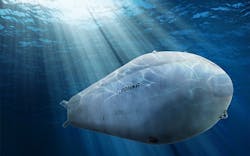Boeing to develop new payloads, capabilities, and missions for Orca large long-range unmanned submarines
WASHINGTON – Undersea warfare experts at the Boeing Co. will develop new capabilities, payloads, and applications for the Orca Extra-Large Unmanned Undersea Vehicle (XLUUV) under terms of an $11.1 million order announced late last month.
Officials of the U.S. Naval Sea Systems Command in Washington announced are asking the Boeing Defense, Space & Security segment in Huntington Beach, Calif., for engineering services to expand the XLUUV's role in future naval operations.
The modular-construction Boeing Orca XLUUV is to be an open-architecture reconfigurable unmanned underwater vehicle (UUV) with the core vehicle providing guidance and control, navigation, autonomy, situational awareness, core communications, power distribution, energy and power, propulsion and maneuvering, and mission sensors, Navy officials say.
Boeing won a $43 million Navy contract in early 2019 to build four XLUUVs, which are autonomous mini-submarines based on the Boeing-designed Echo Voyager large UUV. Echo Voyager’s advanced autonomy enables it to operate in clear and congested waters without physical human contact.
The Echo Voyager has a range of 6,500 nautical miles on one fuel module, can reach depths of 11,000 feet, and can operate independently for months underwater. It is 51 feet long, with a modular payload section as long as 34 feet and a volume of 2,000 cubic feet. Boeing unveiled the Echo Voyager in early 2016 and began sea trials of the unmanned undersea craft in summer 2017.
The large UUV's navigation system uses a Kalman-filtered inertial navigation unit supported by Doppler velocity logs and depth sensors. Powering the vessel is a hybrid combination of batteries and marine diesel generators. It can launch from shore or from large military ships with well decks, or from large civil vessels with moon pools.
The Lockheed Martin Rotary and Mission Systems segment in Riviera Beach, Fla., also has been involved in designing prototype XLUUV systems.
The Boeing Orca XLUUV will have well-defined interfaces for future upgrades to capitalize on advances in technology and respond to threat changes. The Orca XLUUV will have a modular payload bay, with defined interfaces to support current and future UUV payloads.
story continues below
XLUUVs, which are among the largest unmanned submersibles ever conceived, will be for long-endurance surveillance missions or undersea cargo vessels to deliver other sensor payloads and other UUVs.
These large unmanned undersea vehicles eventually could be used as motherships to deploy and recover smaller surveillance UUVs on far-flung reconnaissance, surveillance, or special warfare missions in the open ocean or along coastlines and inside harbors.
The Navy's XLUUV project is moving enabling technologies forward that were developed originally in other projects such as the DARPA Hydra program to develop an unmanned submersible large enough to transport and deploy UAVs and UUVs stealthily in enemy territory to respond quickly to situations around the world.
On this order Boeing will do the work in Huntington Beach, Calif.; and Cockeysville, Md., and should be finished by September 2021. For more information contact Boeing Defense, Space & Security online at www.boeing.com/company/about-bds, or Naval Sea Systems Command at www.navsea.navy.mil.
About the Author
John Keller
Editor-in-Chief
John Keller is the Editor-in-Chief, Military & Aerospace Electronics Magazine--provides extensive coverage and analysis of enabling electronics and optoelectronic technologies in military, space and commercial aviation applications. John has been a member of the Military & Aerospace Electronics staff since 1989 and chief editor since 1995.
